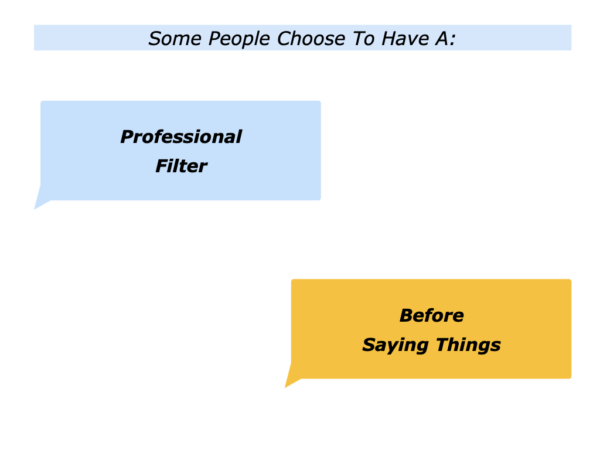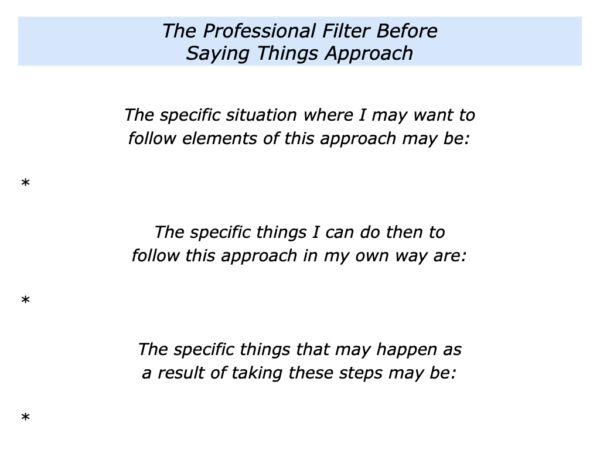
Different people express themselves in different ways. They way they do this can have consequences for both themselves and other people. Looking at professional work situations, for example:
Some people have a professional filter before saying things;
Some people seem to have no filter before saying things;
Some people may have a negative filter before saying things.
Some people may also have positive filters in their personal lives. Before expressing a feeling, they may ask themselves:
“How can I say this in a way that helps rather than hurts people?”
Let’s look at these various approaches and the effects they can have on people.
The Professional
Filter Approach
People who take this approach believe in being true to themselves. They also recognise, however, that the way they communicate can have consequences.
Such people often feel passionate about their work. Some learn how to express this passion in a considered way, however, that is more likely to get positive results.
Bearing this in mind, some people use a professional filter before communicating their feelings, ideas or information Let’s look at an extreme example.
Imagine that a doctor has to give a patient some bad news. They do not greet the patient by saying:
“You are going to die.”
Depending on their own style of communicating, they may instead say something along the following lines.
“We have got the results back and unfortunately it was not what we were hoping for. If you wish, we can go through the results. We can then look at the possible implications going forwards.”
Many people are not faced with such life or death scenarios. They may work in professional environments, however, where they recognise that they are always on stage. The way they behave can have an effect on other people.
Such people therefore buy time before expressing themselves. Bearing in mind the situation, they may then explore the following questions.
“What are the real results I want to achieve? What are the short, medium and long-term desired positive results? Bearing these in mind, how do I want to behave in this situation?
“What are the things I want to say? What may be the information I want to give? What may be options I want to outline? What may be any positive suggestions I want to offer?
“How can I say these things in a way that is more likely to achieve the desired results? How can I be a positive model and behave in a professional way in this situation?”
Some people also follow this approach to their personal lives. Whilst being true to themselves, they try to communicate in a positive way. As mentioned earlier, they may ask:
“How can I behave in a way that helps rather than hurts people?”
Such people recognise that the way they communicate can have a profound effect on their loved ones and other people. Whilst never choosing to be victims, they aim to behave in a way that encourages other people.
The No Filter And
Negative Filter Approaches
Some people do not seem have a filter. They make their feelings a religion and express these through a stream of consciousness. They may or may not be aware of the consequences.
Such people sometimes declare this approach is being honest and true to themselves. That may be so, but speaking without considering for others can create collateral damage.
Some politicians, for example, are admired by their followers for ‘being authentic and telling the truth’. The politician is actually being true about their opinions, however, and using selected anecdotes to prove their case.
Some people may have a negative filter. They focus only on the negative things they see or they express negative opinions about people and events. This can also have an effect on other people.
Let’s return to your own work. Can you think of a situation where you may want to follow elements of the professional filter approach? How can you do this in your own way?
What may be the specific situation? It could be in a meeting or in a conversation. It could be when offering a positive way forward for a person or a group. What may happen as result of taking this approach?
If you wish, try tackling the exercise on this theme. This invites you to complete the following sentences.



Leave a Reply